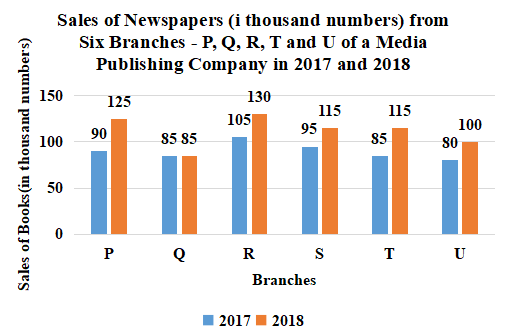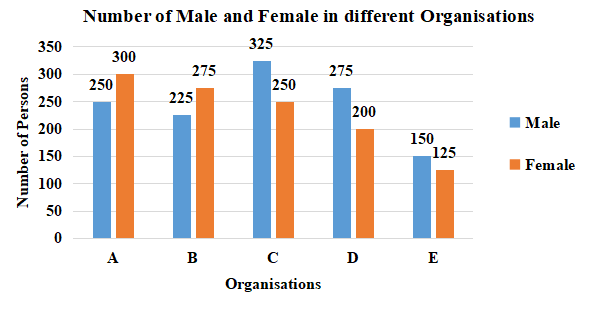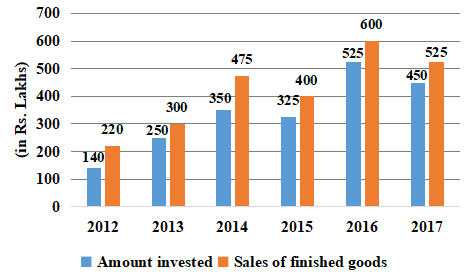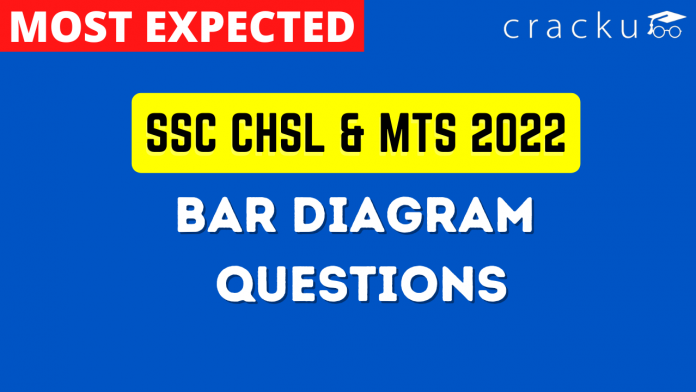Bar Diagram Questions [PDF] for SSC CHSL and MTS
Here you can download the Bar Diagram Questions for SSC CHSL and MTS PDF with solutions by Cracku. These are the most important Bar Diagram questions PDF prepared by various sources also based on previous year’s papers. Utilize this PDF for Bar Diagram for SSC CHSL and MTS. You can find a list of Bar Diagram in this PDF which help you to test yourself and practice. So you can click on the below link to download the PDF for reference and do more practice.
Download Bar Diagram Questions for SSC CHSL and MTS
Enroll to 15 SSC CHSL 2022 Mocks At Just Rs. 149
Question 1: The bar graph given below shows the sales of Newspapers (in lakh number) from six branches of a Media Publication Company during two consecutive years 2017 and 2018.
(Note: The data shown below is only for mathematical exercise. They do not represent the actual figures).

Total Sales of U for both the years is what percent (correct to one place of decimal) of the combined Sales of the branches Q and R for 2017 and 2018?
a) 48.6%
b) 67.1%
c) 44.4%
d) 41.0%
1) Answer (C)
Solution:
Total Sales of U for both the years = 80 + 100
= 180
Total sales of Q for 2017 and 2018 = 85 + 85
= 170
Total sales of R for 2017 and 2018 = 105 + 130
= 235
The combined Sales of the branches Q and R for 2017 and 2018 = 170 + 235
= 405
Required percentage = $\frac{180}{405}\times$100
= 44.4%
Hence, the correct answer is Option C
Question 2: Bar graph shows the number of males and females in five organizations A, B, C, D and E.

What is the ratio of number of males working in organizations C, D and E taken together to that of females working in organizations A, B and C taken together?
a) 10:11
b) 49:46
c) 11:10
d) 46:49
2) Answer (A)
Solution:
Number of males working in organizations C, D and E taken together = 325 + 275 + 150 = 750
Number of females working in organizations A, B and C taken together = 300 + 275 + 250 = 825
Required ratio = 750 : 825
= 10 : 11
Hence, the correct answer is Option A
Question 3: The following bar graph shows the amount(in Lakh Rs.) invested by a Company in purchasing raw material over the years and the values (in Lakh Rs.) of finished goods sold by the Company over the years.

The ratio of total amount invested for purchasing raw material from 2013 to 2015 to the total sales of finished goods in 2014, 2016 and 2017 is:
a) 27 : 56
b) 56 : 27
c) 64 : 37
d) 37 : 64
3) Answer (D)
Solution:
Total amount invested for purchasing raw material from 2013 to 2015 = 250 + 350 + 325 = 925
The total sales of finished goods in 2014, 2016 and 2017 = 475 + 600 + 525 = 1600
Required ratio = 925 : 1600
= 37 : 64
Hence, the correct answer is Option D
Question 4: Bar graph shows the number of males and females in five organizations A, B, C, D and E.

For which organisation, difference between the number of males and the average number of females of all the organisations is minimum?
a) D
b) C
c) A
d) B
4) Answer (D)
Solution:
The average number of females in all the organisations = $\frac{300+275+250+200+125}{5}$ = $\frac{1150}{5}$ = 230
For Organisation A, difference between the number of males and the average number of females of all the organisations = 250 – 230 = 20
For Organisation B, difference between the number of males and the average number of females of all the organisations = 230 – 225 = 5
For Organisation C, difference between the number of males and the average number of females of all the organisations = 325 – 230 = 95
For Organisation D, difference between the number of males and the average number of females of all the organisations = 275 – 230 = 45
$\therefore$ For Organisation B, difference between the number of males and the average number of females of all the organisations is minimum.
Hence, the correct answer is Option D
Question 5: The given bar graph shows the biscuit exports of India over a period of five years. Study the graph and answer the
question that follow.
What was the percentage drop in the export quantity from 2005 to 2006?
a) 75%
b) 100%
c) 50%
d) 25%
5) Answer (D)
Solution:
From the bar graph,
Export quantity of India in 2005 = 100
Export quantity of India in 2006 = 75
$\therefore\ $Required percentage drop = $\frac{100-75}{100}\times100=$ 25%
Hence, the correct answer is Option D
Take a free SSC CHSL Tier-1 mock test
Download SSC CGL Tier-1 Previous Papers PDF
Question 6: The given bar graph shows the biscuit exports of India over a period of five years. Study the graph and answer the question that follow.
In which year, the percentage increase in exports was maximum from its preceding year:
a) 2007
b) 2006
c) 2009
d) 2008
6) Answer (A)
Solution:
From the bar graph,
Percentage increase in exports from 2006 to 2007 = $\frac{150-75}{75}\times100=$ 100%
Percentage increase in exports from 2007 to 2008 = $\frac{160-150}{150}\times100=$ 6.66%
Percentage increase in exports from 2008 to 2009 = $\frac{200-160}{200}\times100=$ 20%
From 2005 to 2006, there was decrease in exports.
$\therefore\ $The percentage increase in exports was maximum in 2007 from its preceding year.
Hence, the correct answer is Option A
Question 7: The given bar-graph represents the number of teachers in different weight groups. Study the graph and answer the question that follows.

In which of the following weight groups is the number of teachers the maximum?
a) 45 – 50
b) 60 – 65
c) 65 – 70
d) 40 – 45
7) Answer (B)
Solution:
From the bar graph,
Number of teachers in the weight group 45 – 50 = 5
Number of teachers in the weight group 60 – 65 = 9
Number of teachers in the weight group 65 – 70 = 5
Number of teachers in the weight group 40 – 45 = 3
$\therefore\ $The number of teachers in the weight group 60 – 65 is highest.
Hence, the correct answer is Option B
Question 8: The given bar graph shows the biscuit exports of India over a period of five years. Study the graph and answer the question that follow.
In which two years was the value per tonne equal?
a) 2006 and 2007
b) 2008 and 2009
c) 2007 and 2008
d) 2005 and 2006
8) Answer (B)
Solution:
From the bar graph,
Value per tonne of the exports in 2005 = $\frac{150}{100}=1.5$ crore/lakh tonne = 1.5 x 10$^{-5}$ crore/tonne
Value per tonne of the exports in 2006 = $\frac{150}{75}=2$ crore/lakh tonne = 2 x 10$^{-5}$ crore/tonne
Value per tonne of the exports in 2007 = $\frac{330}{150}=2.2$ crore/lakh tonne = 2.2 x 10$^{-5}$ crore/tonne
Value per tonne of the exports in 2008 = $\frac{400}{160}=2.5$ crore/lakh tonne = 2.5 x 10$^{-5}$ crore/tonne
Value per tonne of the exports in 2009 = $\frac{500}{200}=2.5$ crore/lakh tonne = 2.5 x 10$^{-5}$ crore/tonne
$\therefore\ $In 2008 and 2009, value per tonne is equal.
Hence, the correct answer is Option B
Question 9: Study the given bar chart and answer the question that follows.
Production of Fertilizers by a Company (in 10,000 tonnes) Over the Years

What was the approximate percentage increase in the production of fertilizers from 1998 to 1999?
a) 44.4%
b) 50%
c) 40%
d) 48.4%
9) Answer (A)
Solution:
From the bar chart,
Production of fertilizers by the company(in 10,000 tonnes) in 1998 = 45
Production of fertilizers by the company(in 10,000 tonnes) in 1999 = 65
Increase in the production of fertilizers of the company from 1998 to 1999 = 65 – 45 = 20
$\therefore\ $Required percentage $=\frac{20}{45}\times100=$ 44.44%
Hence, the correct answer is Option A
Question 10: Given bar graph shows, total expenditure and the gross receipts of a company (in ₹ crores). Study the graph and answer the question that follows.

The total expenditure of the company in 1998-99 exceeds that in 1994-95 by (in ₹ crore):
a) 3800
b) 4800
c) 3700
d) 5500
10) Answer (C)
Solution:
From the bar graph,
Expenditure of the company in 1998-99 = 8500
Expenditure of the company in 1994-95 = 4800
Difference in expenditures in 1998-99 and 1994-95 = 8500 – 4800 = 3700
$\therefore\ $The total expenditure of the company in 1998-99 exceeds that in 1994-95 by (in ₹ crore) 3700
Hence, the correct answer is Option C
Question 11: Given bar graph shows, total expenditure and the gross receipts of a company (in ₹ crores). Study the graph and answer the question that follows.

In order to make a profit of 20%, what should have been the gross receipts (in crore ₹) in 1995-96, if the total expenditure remained the same?
a) 6445
b) 7565
c) 6875
d) 5776
11) Answer (C)
Solution:
From the bar graph,
Total expenditure in 1995-96 = 5500
Let the gross receipts in 1995-96 to make 20% = a
$\Rightarrow$ a – 5500 = $\frac{20}{100}\times$a
$\Rightarrow$ a – $\frac{1}{5}\times$a = 5500
$\Rightarrow$ $\frac{4}{5}\times$a = 5500
$\Rightarrow$ a = 6875
$\therefore\ $The gross receipts in 1995-96 to make 20% = 6875
Hence, the correct answer is Option C
Question 12: Given bar graph shows, total expenditure and the gross receipts of a company(in ₹ crores). Study the graph and answer the question that follows.

What is the percentage increase in the gross receipts in 1996-97 as compared to 1994-95?
a) 41%
b) 44%
c) 42%
d) 43%
12) Answer (B)
Solution:
From the bar graph,
Gross receipts in 1996-97 = 7200
Gross receipts in 1994-95 = 5000
Increase in gross receipts = 7200 – 5000 = 2200
$\therefore\ $Required percentage = $\frac{2200}{5000}\times100$ = 44%
Hence, the correct answer is Option B
Question 13: Given bar graph shows, total expenditure and the gross receipts of a company (in ₹ crores). Study the graph and answer the question that follows

If profit = gross receipts — total expenditure, then in 1997-98, what percentage of gross receipts is the profit made?
(Correct to one decimal place)
a) 4.8%
b) 5.4%
c) 3.9%
d) 6.1%
13) Answer (D)
Solution:
From the bar graph,
Gross receipts in 1997-98 = 8200
Total expenditure in 1997-98 = 7700
Profit in 1997-98 = 8200 – 7700 = 500
$\therefore\ $Required percentage = $\frac{500}{8200}\times100$ = 6.097% = 6.1% (approximately)
Hence, the correct answer is Option D
Question 14: The given bar chart shows the number of students in a class who have secured marks in three ranges: >=75%, 60%-74% and <60%.

From the given information, identify how much percent of girls got distinction.
a) 18.49%
b) 14.28%
c) 17.86%
d) 10.76%
14) Answer (D)
Solution:
From the bar chart,
Percentage of girls who got distinction = $\frac{\text{Girls\ who\ got\ more\ than\ 75\%}}{\text{Total\ number\ of\ girls}}\times100$ = $\frac{7}{7+53+5}\times100$ = $\frac{7}{65}\times100$ = 10.76%
Hence, the correct answer is Option D
Question 15: The given bar chart shows the number of students in a class who have secured marks in three ranges: >=75%, 60%-74% and <60%.


What is the total number of girls and boys?
a) 120
b) 130
c) 110
d) 140
15) Answer (B)
Solution:
From the bar chart,
Total number of girls and boys = (7 + 53 + 5) + (12 + 45 + 8) = 65 + 65 = 130
Hence, the correct answer is Option B
Question 16: The given bar chart shows the number of students in a class who have secured marks in three ranges: >=75%, 60%-74% and <60%.

From the given information, identify the per cent of boys who got distinction.
a) 15.29%
b) 18.46%
c) 16.78%
d) 13.98%
16) Answer (B)
Solution:
From the bar chart,
Percentage of boys who got distinction = $\frac{\text{Boys\ who\ got\ more\ than\ 75\%}}{\text{Total\ number\ of\ boys}}\times100$ = $\frac{12}{12+45+8}\times100$ = $\frac{12}{130}\times100$ = 18.46%
Hence, the correct answer is Option B
Question 17: The given bar chart shows the number of students in a class who have secured marks in three ranges: >=75%, 60%-74% and <60%. What is the ratio of percentages of boys and girls who got marks from 60% to 74%?
What is the ratio of percentages of boys and girls who got marks from 60% to 74%?
a) 64.12 : 88.23
b) 62.78 : 82.67
c) 69.23 : 81.53
d) 67.54 : 87.45
17) Answer (C)
Solution:
From the bar chart,
Number of boys who got marks from 60% to 74% = 45
Percentage of boys who got marks from 60% to 74% = $\frac{45}{12+45+8}\times100=\frac{45}{65}\times100=69.23\%$
Number of girls who got marks from 60% to 74% = 53
Percentage of girls who got marks from 60% to 74% = $\frac{53}{7+53+5}\times100=\frac{53}{65}\times100=81.53\%$
$\therefore\ $The ratio of percentages of boys and girls who got marks from 60% to 74% = 69.23 : 81.53
Hence, the correct answer is Option C
Question 18: The following bar graph shows the number of deaths from road accidents occurred during the rainy season in the year 1992. Study the graph carefully and answer the question.

Between which two consecutive weeks was the fall in the number of deaths the greatest?
a) 7 July to 14 July
b) 21 July to 28 July
c) 30 June to 7 July
d) 28 July to 4 August
18) Answer (A)
Solution:
From the bar graph,
Fall in the number of deaths from 7 July to 14 July = 180 – 145 = 35
Fall in the number of deaths from 28 July to 4 August = 160-150 = 10
There was a rise in number of deaths from 30 June to 7 July and 21 July to 28 July
$\therefore\ $The fall of number of deaths is greatest from 7 July to 14 July
Hence, the correct answer is Option A
Question 19: The given bar graph represents the Percentage of non-electrified villages in 6 states A, B, C, D, E and F. Study the graph and answer the question that follows.

How many states have at most 30% or less non-electrified villages?
a) 3
b) 2
c) 1
d) 4
19) Answer (A)
Solution:
From the bar graph,
The states that have at most 30% or less non-electrified villages are A, C, E
$\therefore\ $Number of states that have at most 30% or less non-electrified villages = 3
Hence, the correct answer is Option A
Question 20: The following bar graph shows the number of deaths from road accidents occurred during the rainy season in the year 1992. Study the graph carefully and answer the question.

Between which two consecutive weeks was the rise in the number of deaths the greatest?
a) 4 August to 11 August
b) 30 June to 7 July
c) 14 July to 21 July
d) 21 July to 28 July
20) Answer (B)
Solution:
From the bar graph,
Rise in number of deaths from 30 June to 7 July = 180-142 = 38
Rise in number of deaths from 14 July to 21 July = 155-145 = 10
Rise in number of deaths from 21 July to 28 July = 160-155 = 5
Rise in number of deaths from 4 August to 11 August = 165-150 = 15
Hence, the correct answer is Option B





